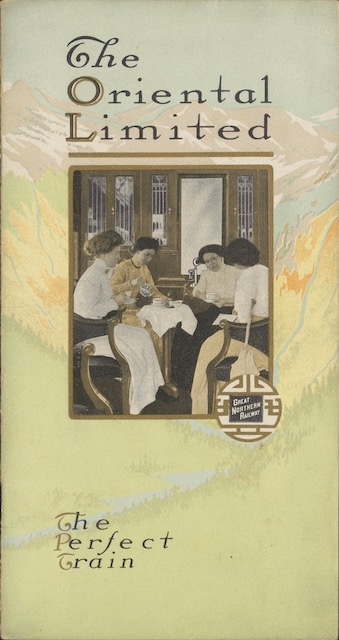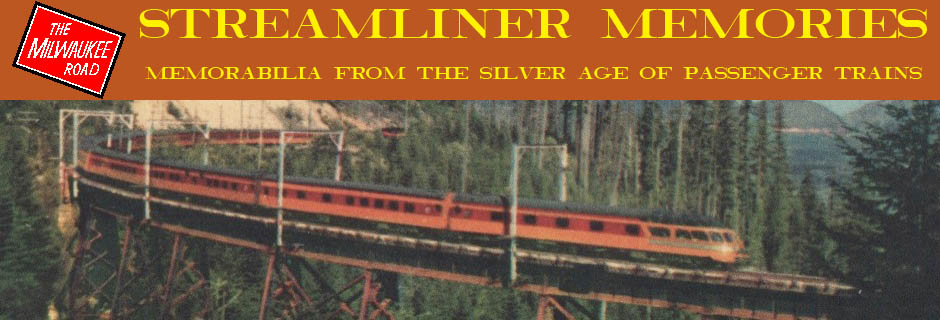Introduced in 1905, the Oriental Limited was the pride of the Great Northern. This 1911 booklet says that the train had “recently been augmented by the installation of entirely new equipment throughout.” The new cars had electric lights, wide vestibules, “vacuum cleaning machines” operated by a uniformed attendant whose sole job was to keep the train “neat and clean,” and an on-board telephone that only worked when the train was in the Chicago, St. Paul, or Seattle stations. Twice a day, the train received telegraphed news bulletins of the latest world events.
 Click image to download a 5.3-MB PDF of this 20-page booklet plus map.
Click image to download a 5.3-MB PDF of this 20-page booklet plus map.
“Many people, especially ladies, feel the need of some light refreshment during the interval between luncheon arid dinner,” says the booklet, and Great Northern provided this in the form of an afternoon tea every day between 4 and 5 o’clock. This tea service was available to sleeping car passengers at no extra charge.
The booklet briefly mentions two other trains. The Oregonian, like the Oriental Limited, had electric lights and daily news bulletins, but only went as far east as St. Paul and didn’t have an observation car. The Great Northern Express was the westbound name of a train that was called the Southeast Express eastbound and it connected Seattle with Kansas City via the Burlington Route. It was equipped comparably to the Oriental Limited including a compartment-observation car.
Diagrams in the booklet show that the compartment-observation car on the Oriental Limited had four “state rooms” with room for two people each. The common rooms in the car included a ten-seat smoking room, an observation room with seating for 15 passengers, and a large open platform on the rear. The car also had a small buffet for serving tea and other beverages and snacks. Presumably the observation car on the Kansas City train was similar.
The diagrams also distinguish between standard sleepers and tourist sleepers. The former had 12 sections (24 beds) and a drawing room with three beds. The latter had 14 sections or 28 beds. The rest rooms in the tourist sleeper were smaller but the car included a range and sink so passengers could prepare their own meals en route. Tourist sleeping car passengers didn’t have access to the observation car.
The back of the booklet has a fold out with a map of the Great Northern and July 1911 timetables for all three trains. Between Chicago and Seattle, the Oriental Limited took 72 hours for an average speed of 31 mph. The Portland section over the Spokane, Portland & Seattle was slightly faster at 32 mph. The Kansas City train was slower, averaging just 27 mph.
The eastbound timetable for the Oregonian appears to contain an error. Westbound, the train required 60-1/4 hours from St. Paul to Seattle for a reasonable speed of 30 mph. Eastbound, the timetable says the train needed 72-1/2 hours for an average speed of 25 mph. However, the arrival times in St. Paul appear to be wrong; they say the train arrived at 7:05 am, whereas a 1913 timetable shows it arriving at 10:45 pm the night before. It doesn’t make sense for the train to take 12 hours longer in one direction than in the other, so even if the timetable in the booklet was accurate for 1911, it would have been speeded up soon after.
